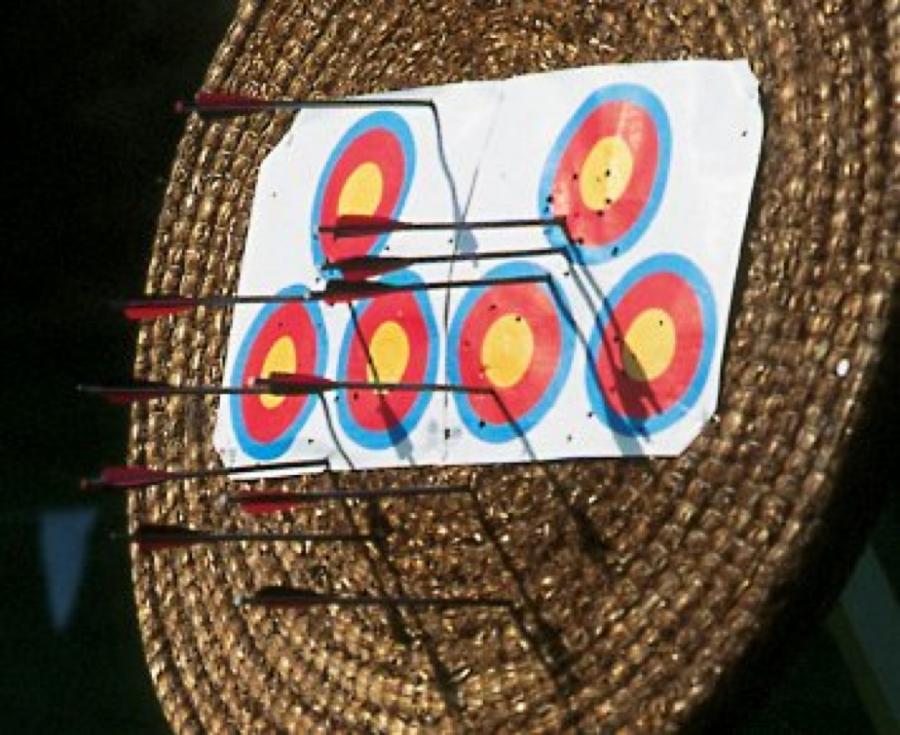This website uses cookies to help deliver its services. By using this website, you agree to the use of cookies as outlined in our Privacy Policy.


It is evening as I write this and the archery course is in full swing in our indoor facility here in Boyne Valley Central. I can hear the thunk of arrows flying into butts and cheers when someone hits the target. It sounds like Jim, our Olympic archery instructor, is putting a group through their paces. I have been out on the river earlier with a bunch of culturally curious tourists bringing them down by Trim Castle and into Newtown Cathedral on a medieval tour and I need to get this month’s blog out. But I would really rather be in the long room next door loosing a few arrows from the bow. There is something much more relaxing about a spot of archery than staring at a flashing screen.
So I pop next door to see how they are getting on. I listen to Jim explain how in the olden days archery was not a sport. It was a matter of life and death. Archery was one of those interesting developments, like agriculture and cooking, which happened around about the same time in different parts of the world. It was like the world back then had it’s own hashtag system. One minute everyone was fecking stones at things and the next thing everyone was all about the #archery. No-one knows who came up with the idea of transferring energy from a bent wooden stick into a smaller stick by pulling back a string so that the smaller stick would go further and faster than a spear, but whoever did it, they really should have patented it.

Of course, it has changed a bit since then. During prehistory, Irish archery was most likely used for hunting (although there was a famous prehistoric human bone found in Poulnabrone Dolmen with an arrow embedded in it). As the world became more civilised and sophisticated, it was only a matter of time before people came up with the idea of using this new technology to kill each other. The Egyptians are credited with first using longbows in battle. The Assyrians invented the compound bow so they could shoot from moving chariots. Even back then, trick shots were always popular in archery. Strangely, the Irish appeared to stop using the bow and arrow from the early Bronze Age until about the 10th century. Noone knows why. It just disappeared out of the archaeological record until the Vikings and Normans arrived. Of course, Boyne Valley Activities wasn’t around back then.
The Vikings were big into anything that could inflict damage. Viking towns like Dublin, Waterford and Limerick are full of bits of bows and arrowheads and the vast majority of styles were of a particular type that were designed to pierce chainmail and armour. These were definitely not used for hunting rabbits and pigeon. The annals that tell of the Battle of Clontarf mention the use of bows and arrows by the Vikings, but at heart, they were an axe-loving people (which might explain the number of death metal bands from those countries?

The Normans loved their archery. Excavations at Trim Castle demonstrate this through the number of arrowheads found within the grounds. The arrow loops in the curtain wall are designed to accommodate archers. Before it was a castle, it was a motte and bailey and the archers used the height of this structure to send arrows down on any Irish unfortunate to come within arrow distance. The Normans had already used archery to great effect against the Anglo Saxons, knocking out their King with an arrow in the head. When they came to Ireland, 85% of the soldiers were classed as archers according to the chronicler, Cambrenis. These were corps of Welsh archers who let great volleys of arrows against any armies foolish enough to meet on an open field for battle. Fighting was very messy in those days. Arrows would injure horses and men. Most died by being trampled on top of each other. Norman knights got all the glory with their joust training, fancy horses and epic swords but like a lot of heroes who stay alive, they just showed up, took a few medieval selfies and took credit for all the work. The archers were the guys who had to train from a young age and be able to let loose arrows in quick succession.

Once the Norman period was in full swing in Ireland, archery really began to develop here. Irish archers started to appear in the annals. Bows got longer and deadlier and the arrows changed to make it through plate armour. Trim was essentially a colony town in the badlands and laws were made to ensure that there was a always a contingency of archers on hand to protect the settlers from attack. Training in archery was mandatory. It was like the FCA for bows and arrows. Butts had to be placed in each large house for a spot of lunchtime target practice.
It was this need for constant practice that was the downfall of archery in the late middle ages. It was not that it was hard. It just requires work if you want to be the next Legolas of Gondolin or Katniss from District 12. If you even breathe wrong, your aim can get thrown off. Any eegit can shoot a musket though. Just point and click. When guns began to arrive on the scene, their ease of use for defence meant that they soon replaced bows in the 17th century.
Happily, we don’t use bows for defense in the Boyne Valley. All we are interested in is the joy of hitting the target.
If you fancy signing up for our archery evenings, check us out here


